The 4-16×44 FFP Combines Value with Performance
Recently, I was afforded an opportunity to evaluate a Vortex Diamondback Tactical FFP scope. As tempting as it was, rather than snap up a high-end model, I went another route. Many shooters just aren’t in a position to spend thousand dollars or more on a premium scope. Also, like a growing number of others, I was having fun stretching the range of the diminutive .22 LR cartridge to well beyond 100 yards – but was limited by the scope.
My Anschutz 1416 D HB was up to the task. Using .22 LR Federal Gold Medal Target or Eley Force, it was capable of one-MOA groups beyond 100 yards. However, the scope’s one-inch design was struggling to provide the necessary elevation. Thus, the prospect of a 30mm Vortex with greater adjustment capabilities was a well-timed offer of further interest to centerfire shooters.
Are Vortex Scopes Any Good?
Vortex has been coming on strong in recent years. They create a healthy balance between quality and affordability. This makes them a popular choice for shooters and hunters, offering a fair value for the product. These are not sniper quality scopes, but they are good scopes nonetheless.
They catalog a comprehensive line of scopes (and other optics) ranging from high-end Razor models (up to $3,700), to low-cost Crossfires ($200). The Diamondbacks fall closer to the lower end, but the three Tactical versions are a cut above. Their turrets are exposed target types. Choices include a one-inch 4-12×40 ($350), 30mm 4-16×44 ($450), and a 30mm 6-24×50 ($500); the last two being side-focus, first focal-plane (FFP) types.
Vortex Diamondback Tactical FFP
One advantage of a First Focal Plane (FFP) scope involves today’s range-compensating reticles which incorporate hold-points in their crosshairs. Unlike most 2nd FP types that only calibrate (as advertised) at maximum magnification, the trajectory values of FFP reticles remain constant regardless of the setting. A downside is the visibility of the reticle itself, which becomes finer as magnification decreases. Those with precise lines can be difficult to resolve at the lower end.
No products found.
Also (although less utilized), unlike a 2nd FP type, you can’t alter the ballistic values by changing the magnification – a trick I’ve occasionally used to fine-tune a reticle to a specific trajectory. Since none were available in the higher powered 30mm Diamondback Tactical versions, I went with the 4-16×44. You can get this scope two ways; both featuring EBR-2C Reticles, in either MRAD or MOA patterns.
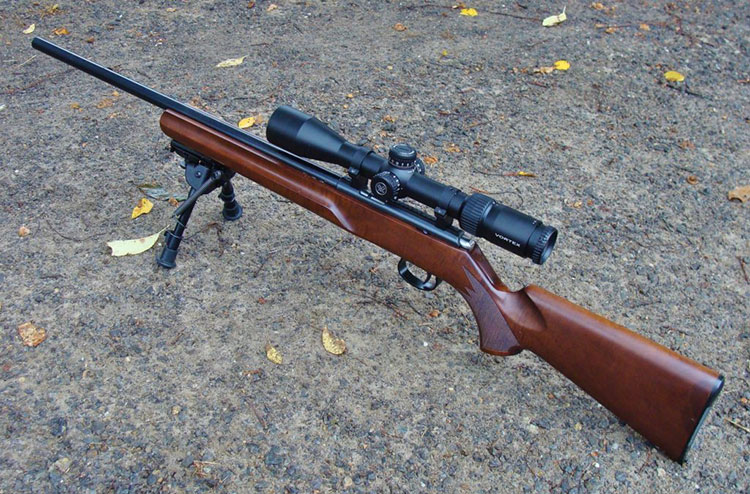
I’m guessing the EBR stands for “etched ballistic reticle” with its numerous fine lines are etched into glass (unlike older delicate wire designs). Most serious tactical shooters will opt for an MRAD system (based on milliradians), for target-ranging purposes. But, I stuck with the MOA design which has stronger sporting routes that mirror my own experience.
MOA note: one “minute-of-angle” is 1/60th of a degree, which works out to roughly one inch at 100 yards (actually, 1.047”). Because it’s an angular measurement, at twice that distance – 200 yards – 1 MOA also doubles, making it about two inches. Or, at 50 yards, an MOA is only around a half-inch. More on this shortly.
Unboxing the Scope and Firing the First Shots
Crazy as it sounds, right off the bat, one feature I liked was the scope’s packaging. The pertinent specifications (normally available only through extra searching) were clearly printed on the box. I’ll let the packaging cover these details. A sunshade tube, lens cloth, elastic caps, and very clear set of directions were also included.
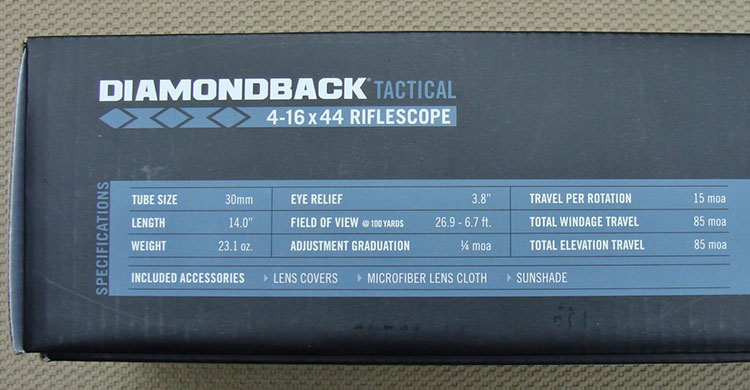
Each turret is clearly numbered with clear directional arrows, and provides 15 MOA per revolution,. The clicks are well-defined and correspond with the ¼ MOA graduations. The drums also resettable to “0” but no zero-stop is provided. Total travel for both is listed as a generous 85 MOA; one reason I chose this model. On top of that, the reticle affords additional hold-over elevation.
The juncture of the reticle’s fine crosshairs is interrupted by a small space so that small targets won’t be obscured. Each has intersecting tick-marks every 2 MOA, and every fourth one (from 4 MOA to 34 MOA) is numbered. A descending “Christmas tree” pattern corresponds with the lower graduations, providing 1 MOA wind-drift dots. Despite the plethora of reference marks, to me, it doesn’t seem overly cluttered, probably because the graduations are so precise.
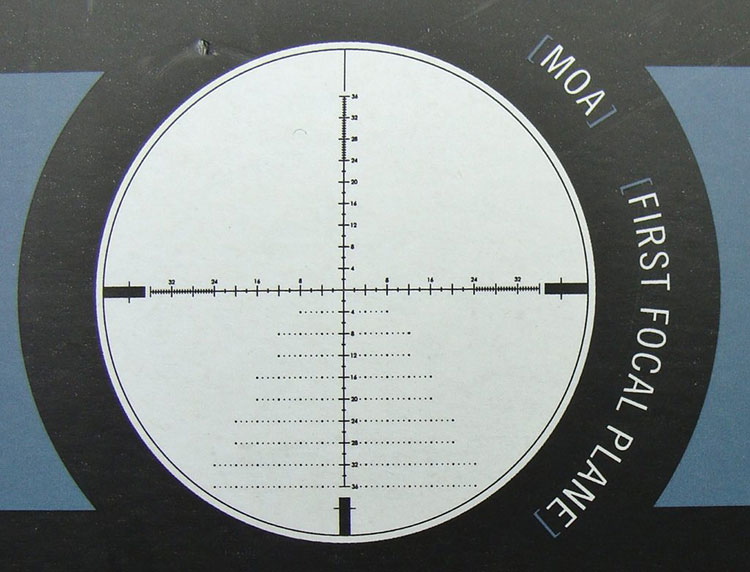
Anticipating this scope’s arrival, I’d already purchased a set of aluminum 30mm Warne #732M-High rings. They’re light but sturdy and, by reversing their clamping jaws, they can be mounted to the grooved receivers seen on many rimfire rifles, whether the common U.S. 3/8-inch pattern, or wider-spaced 11mm European variation (like my Anschutz). I took extra time to level the scope.
Still, the entire mounting process was easy thanks to a generous main-tube length and eye-relief of almost four inches. The reticle became clearly defined after twisting the fast-focus eyepiece which, due to my old eyes, required lots of twists. Bore-sighting was equally easy, only requiring five MOA of elevation.

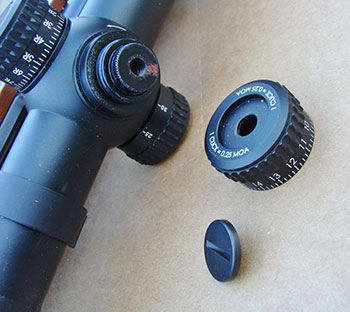
After just a few shots, the precise ¼-MOA turret graduations put me on the money at 50 yards. Next, it was time to “zero” the resettable turrets. A wide slotted screw retains each drum.
Using a coin, I loosened the elevation drum’s screw and attempted to pull it upward until it would disengage to reset.
At first, it refused to budge. A harder tug did the trick but both the drum and its screw launched upward, the latter to parts still unknown. How it could disappear on in the open surface surrounding the shooting bench is almost spooky, but it’s apparently gone for good.
After fruitless searching, I reinstalled the drum through a firm downward press, while aligning its “0” with a witness mark. Fully seated, fine teeth within the hollow drum engaged a corresponding set on a separate stem. The fit was firm enough that it still worked, but I called it quits and phoned Vortex.
Here’s where things got much better. Vortex advertises a VIP warranty. Although never mentioning the scope’s test status, within a couple days, two new retainer caps appeared along with a Vortex hat and a few other promotional goodies – all for no charge. That’s great service! And, if I’d thoroughly read the instructions, none of this would’ve have been necessary.
Vortex Diamondback Tactical Range Evaluations
Some scopes begin to wander near the upper limits of their elevation adjustments as spring pressure on the reticle-assembly decreases. Other problems may be inconsistent (or indistinct) adjustments, and impact-shifts during magnification changes. The yardage scales of some parallax-adjustable types don’t match up with actual distances (see below) and, across the board, optical quality can vary.
When it comes to lenses you’ll often get what you pay for, but reliable adjustments also count. Some scopes are zeroed once and then ignored. Others – especially those featuring target turrets – get cranked repeatedly. That’s okay as long as the adjustments are up to it.
A tracking test can reveal some of these issues so, using a T-square, I drew a bold vertical line on the center of a white IPSC target from its lower edge to the head. A small aiming square was added to the bottom of the line and, above it, intersecting lines were applied in five-inch increments (the last at 25-inches). The tracking target was then stapled to a larger backer, using a plumb-line to ensure it was vertical. As long as a scope is mounted level, its vertical crosshair can be precisely aligned with the target to eliminate false canting errors.
This system is a good way to plot the accuracy of a scope’s turret adjustments which, ideally, will coincide with bullet impacts. The target also provides a way to compare the values of a ballistic reticle against measured points.
Tracking Check
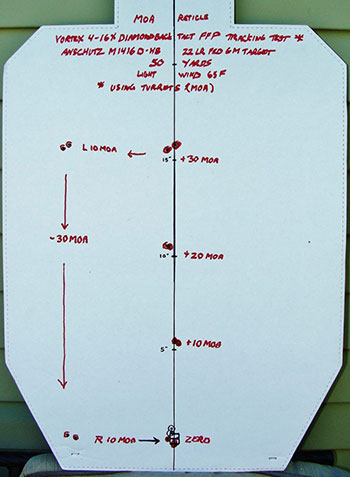
Centerfire testing often occurs at 100 yards, but I was shooting a .22 rimfire, which is much more vulnerable to wind-drift. As soon as I hit the range a light breeze kicked up so, to minimize its effect, I moved in to 50 yards and limited each group to a pair of carefully-timed shots. I started on the lower square.
Then, while continuing to aim at it, I dialed up 10 MOA (roughly 5 inches) and fired two more shots. This process continued in 10 MOA increments up through 30 MOA. At that point I dialed left 10 MOA, came back down a full 30 MOA, and finally 10 MOA right back to “0.”
While shooting this “box,” the turrets adjusted crisply and the last two shots in the square struck darn close to the first pair. The Anschutz and Federal Gold Medal Target combination also performed well, permitting a fair evaluation of the adjustments. The vertical groups are a bit above the five-inch lines but, actually, they coincide with the MOA adjustments (about 5% greater). I was impressed!
*Turret-travel note: Upon reaching 30 MOA I called a brief time-out from shooting, but kept adding clicks to determine the turret’s upper limit. As mounted, it turned out to be 37 MOA.
Once the tracking test was complete, superimposing the reticle on the target’s grid showed its MOA graduations were calibrated as advertised. Because the scope is FFP, magnification changes won’t alter them.
Magnification-related POI Shifts
On a different day in calmer air, I moved back to 100 yards, dialed up 6 MOA, and fired three-shot groups at four magnification settings; 16X, 12X, 8X, and 4X. The targets were four small squares drawn on a white IPSC backer. As suspected, resolution of the squares on the highest three settings were no problem – but I had a heck of a time at 4X. On a whim, I switched to a nearby ten-inch white steel plate showing previous bullet impacts and lined up on a lone spot at 3:00. That worked! Conclusion: If there were any magnification related POI shifts, they were minimal.
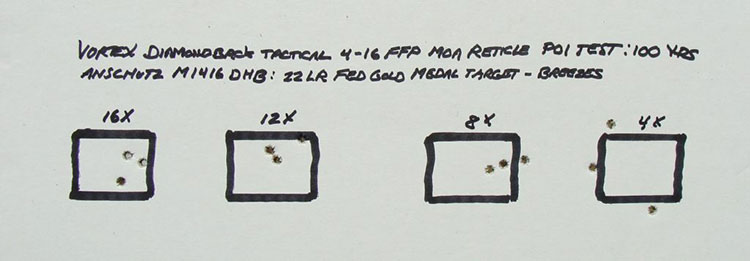
Scope Parallax
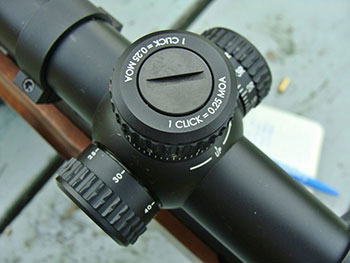
If a target’s image and the reticle are not on the same focal plane some misalignment is possible, especially when viewed off-center. An indication of parallax is a shift of the reticle on a target as the head is moved around. At extreme distances (long or very close) involving small targets, the result could be a miss.
This is less of a concern for most big game hunters, so most sporting-type scopes incorporate fixed settings of 100 – 150 yards. On the other hand, many rimfire/airgun, or varmint/tactical scopes, feature a separate parallax-correctable system which can be adjusted to a specific yardage.
The Diamondback Tactical uses a side-focus knob located opposite its windage turret, and the graduations begin at 20 yards (of interest to rimfire shooters). Although some yardage scales don’t coincide with actual distances, this one turned out to be darned close.
Stretching the Distance
As mounted on my Anschutz, between the elevation turret’s 37-MOA upper limit, and the reticle’s extra hold-points, it looked like more than enough elevation was available to reach 300 yards or more – quite a stretch for a .22 LR.
200 Yards
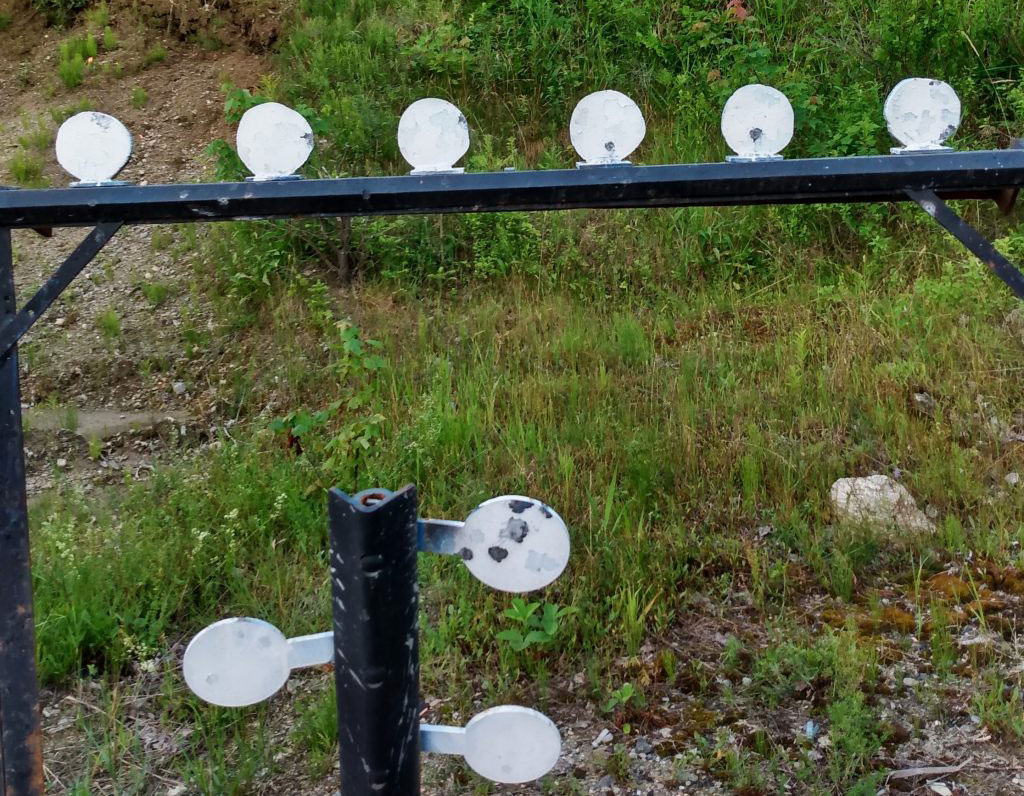
Starting from a 50-yard zero (with 40-grain Federal GMTs at 1145 fps), I easily achieved zero by dialing up 22 MOA. In centerfire terms, it’s the equivalent of a 750-yard shot from my .308 if zeroed at 200-yards. The reticle’s horizontal ticks also provided a handy 1 MOA windage correction, resulting in regular hits on 4-inch steel disks off a bipod. Fun!
300 Yards
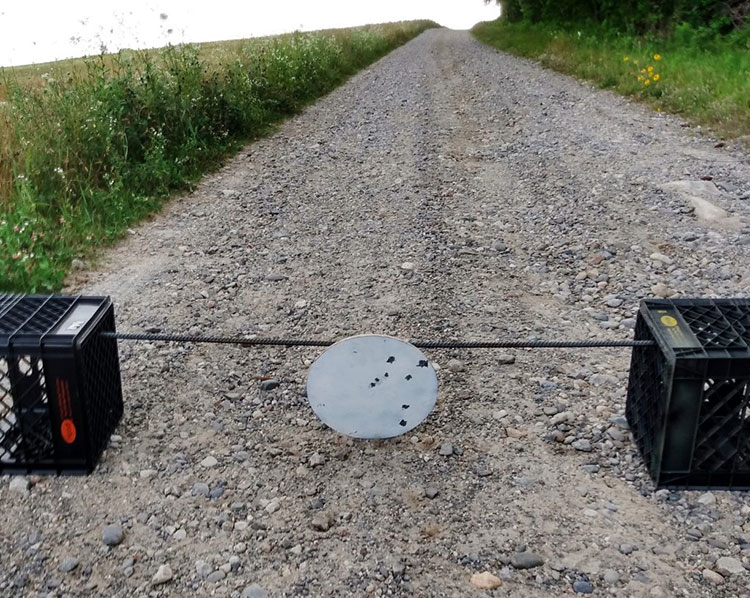
Engaging a 12-inch steel disk, the magic combination was two full turret rotations (+30 MOA), plus 12 MOA using the reticle’s descending grid – the equivalent of 1000 yards with the .308! A very light 9:00 breeze was easily addressed through its corresponding wind-points. Hits came with regularity.
Optical Quality
Resolving .22 bullet holes (and the tracking-target’s small reference marks) was easy at 100 yards, discounting 4X. All hits on the longer-range steel targets were also clearly visible in evening light. At 300 yards, I did encounter some difficulty maintaining a full image while using the reticle’s lower hold-points. Some of this was due to my lousy position (stretched over the hood of my truck), but it turned out this scope is also touchy at its highest settings. Thanks to the FFP reticle though, I was able to improve imagery by stepping down to a still-useful 12X.
Later, I compared this 4-16×44 Diamondback to a 1” Leupold VX-3 4.5-14x40mm with a precise “Varmint Hunter” Reticle. The Leupold has served me well for more than a decade on everything from prairie dogs to eastern coyotes (often well after sundown). So, for this non-shooting test, shortly before sunset, I placed the initial tracking target at 100 yards and, after adjusting both scopes to 14X, switched back and forth from a solid rest as the light began to fade.
The Vortex compared surprisingly well, even when viewing some darker shaded objects within the adjacent woods. However, I did encounter some edge distortion which, combined with the touchy image, created challenges using the lowest ballistic reticle points.
Once again, the solution was to crank the Vortex down to 12X. It then compared similarly to the Leupold set on 14X. Twenty minutes after sunset though, the fine Vortex reticle became extremely difficult to resolve. The Leupold was still going despite its 1” tube, mostly because the graduations of its VH reticle were a bit bolder. To be fair, it also cost considerably more ten-plus years ago.
Final Take
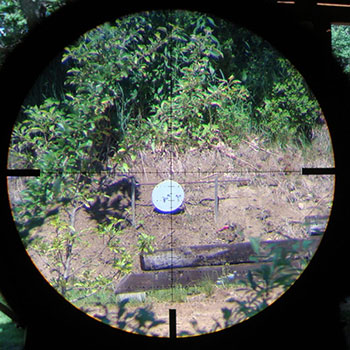
First, a few gripes. At other than a well-centered position, maintaining a full image was tricky at the highest magnification settings, which impeded full use of the reticle.
Zero-stops would be a nice addition, but they’d no doubt increase the cost.
Also, a horizontal scale below the elevation drum would help gauge the number of rotations. And, even at maximum power, the FFP reticle is far from bold (as it should be for maximum precision).
For most hunting purposes involving big game, a lower-powered 2nd FP scope with a bold reticle would be a much better choice but, of course, that’s not the purview of this model.
Lastly, although much more satisfactory than another recent import, fine print below the box’s bar code reads “Made In China.”
But, balancing features and quality against its cost, the Diamondback Tactical seems like a pretty good deal. I’d shop for a higher-end version if fast-roping or serious social occasions were in the cards but, nowadays, I have enough trouble just exiting my truck.
On the other hand, this FFP scope could provide a path for increasingly popular long-range .22 LR Precision Rimfire events. The longer-range equivalent is centerfire Precision Rifle. The jury’s still out for me regarding this scope’s steady use with calibers like the 6.5 Creedmore or .308, but Vortex does offer that VIP warranty. Meanwhile, I wouldn’t hesitate to use it during another high-volume prairie dog safari atop an .17 HMR or .223, etc.
The Vortex Diamondback Tactical FFP scope varies in price depending on the retailer and any sales they have going on. If you want to buy one, check the following retailers to see who is offering the best deal, and if you are shopping Bass Pro Shops or Cabela’s, both retailers have cash back offerings through Rakuten.
| Scope | Retailer Link |
|---|---|
| Vortex Diamondback Tactical | Bass Pro Shops |
| Vortex Diamondback Tactical | Brownell’s |
| Vortex Diamondback Tactical | Cabela’s |
| Vortex Diamondback Tactical | Optics Planet |
| Vortex Diamondback Tactical FFP | Bass Pro Shops |
| Vortex Diamondback Tactical FFP | Brownell’s |
| Vortex Diamondback Tactical FFP | Cabela’s |
| Vortex Diamondback Tactical FFP | Optics Planet |
Your thoughts?